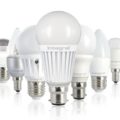Although you might groan at the thought of European Union (EU) law, stay with us. The EU has passed rules to ensure you can buy good quality LED spotlights when you want to replace less efficient halogen bulbs. The Energy related Products (ErP) directive is effective from 1st September 2013. The purpose of these rules is to protect your interests as a consumer.
Spotlights
Spotlights, also known as directional bulbs, have been a popular means of lighting for years. You can install them in ceilings, and under shelves or cupboards, to create what designers refer to as “accent lighting”.
Many householders use spotlights in kitchens, bathrooms and living areas. The bulbs also appear in businesses such as pubs, shops and restaurants.
The standard spotlight bulb is a 50-watt (50W) halogen. This usually casts a beam of clear white light at an angle of up to 90 degrees.
Halogen bulbs vs LED light bulbs
The drawback to halogen bulbs is the amount of electricity they use and their lifespan. For example, if you have six 50W halogen bulbs in your kitchen, you’re using 300W of electricity each time you switch them on. And you can expect the bulbs to last no more than 2,000-2,500 hours.
Good quality LED spotlight equivalents are cheaper to run and last longer. You simply place them in your existing fittings. They consume just 5W of electricity each and have a life expectancy of around 30,000 hours.
Taking the example given above, six LED spotlights would use 30W of electricity compared to 300W. That’s quite a saving for your energy bill. What’s more, you don’t have to replace your LED spotlights for years.
Level of brightness
When it comes to electricity consumption and lifespan, you can choose LED spotlights with confidence. But you also need to be sure LED light bulbs give at least the same level of brightness, or are even brighter, than the halogen bulbs you’re replacing. This is where the new EU rules come in.
When you shop for LED spotlights, you may have noticed how retailers compare the bulbs to halogens. For instance, you could see a 5W LED spotlight marketed as the equivalent to a 50W traditional halogen bulb.
However, wattage is not a measure of a bulb’s level of brightness. It relates to power consumption and shows the money you can save in electricity by switching to LED. To know the level of brightness you can expect from a bulb, you need its lumens rating.
Useful lumens
Before the new rules appeared, you might find a reference to the luminous intensity (or candela) of a spotlight on the packaging. This could be confusing. Luminous intensity refers to the intensity of light a bulb emits – not the level of brightness.
A lumens rating measures the level of brightness of a bulb, or in other words its light output. EU rules now require spotlight manufacturers to give each bulb a lumens rating.
This isn’t quite as straightforward as it seems, though. Spotlights send light in a specific direction. Therefore the rules say a lumens rating must relate to the quantity of “useful” light a bulb emits within a given angle.
A manufacturer must therefore measure the amount of lumens in a 90-degree cone projected from a spotlight bulb in a forward direction. The name given to the light output within this cone is “useful lumens”.
Spotlight accuracy
As a result of this change, you have an accurate measure of a spotlight’s level of brightness. You can be confident the useful lumens rating of a bulb is the amount of light you will receive within the beam cone.
With the new rules, you can also be sure a spotlight is a true directional bulb. If a bulb has a beam angle greater than 90 degrees, a retailer should not sell it for accent lighting. Moreover, a retailer cannot refer to such a bulb as a 50W spotlight equivalent.
LEDS and useful lumens
When you’re planning to replace your halogen spotlights with LED equivalents, look for the lumens rating. The manufacturer might not refer to the rating as useful lumens, only as lumens. Nonetheless, the new law obliges the manufacturer to measure the rating in the way described above.
Take a GU10 spotlight bulb, for example. You may already have seen 5W LED GU10s sold as 50W equivalents. As explained above, this is fine as far as energy savings go, but you need to check the light output of the LED. So look for the lumens rating.
The legislation contains a table of wattages and useful lumens’ outputs. If you want to replace a 35W halogen with an LED GU10, you need a useful lumens rating of 200. For a GU10 LED to be the equivalent of a 50W halogen, you want 300 useful lumens.
Another popular spotlight bulb is the MR16. These bulbs run on 12-volt systems around the home, in offices, and in caravans and boats. For an LED MR16 bulb to be the equivalent of a 35W halogen, you’re looking for a useful lumens rating of 340. To be an effective replacement for a 50W halogen, you want an LED MR16 to have a useful lumens rating of 540.
Other spotlight information
The EU rules also require manufacturers to publish other facts and figures about their bulbs. The goal is to help you buy a good quality product and safeguard your rights as a consumer.
Such information includes the following.
- The starting time of a bulb in seconds.
- The anticipated lifespan of a bulb.
- The switching cycles. This refers to the number of times you can switch a bulb on and off before it loses light output or fails.
- The beam angle of a spotlight.
- Lumen maintenance. This gives the time a bulb works before the level of brightness could begin to reduce.
- The power factor. This figure is the ratio between the wattage of a bulb, known as real power, and the bulb’s volt-ampere measurement, known as apparent power. A bulb with a low power factor uses more electrical current than one with a high power factor.
- The lamp survival factor. This tells you what proportion of bulbs you can expect to be working after a certain period for a lighting installation.
- Premature failure rate. This is the anticipated failure rate of a bulb before it reaches the end of its usual lifespan.
Colour render index
Among further technical information now available under the EU rules is a bulb’s colour render index. You could find this handy because it tells you what colour of light you can expect a bulb to produce.
For example, a white bulb with a colour render index of less than 85 (expressed as <85) may give a room a yellow or even green tint. A bulb with a colour render index of more than 85 (expressed as >85) produces a warm white appearance. You might therefore prefer a bulb with a colour render index of >85.
If you are unsure which bulbs will meet your needs, or if you’d like advice on the new EU legislation before buying LED light bulbs, our advisors are on-hand to help. Just get in touch.
Date: October 8, 2013
Tags: announcements environmental industry led LED Lighting new news technology
The EU has passed rules to ensure you can buy good quality LED spotlights when you want to replace less efficient halogen bulbs.





I have 3 light fittings in my kitchen each holding 3×50 watt halogen GU10 bulbs, needless to say I very rarely use them. Which LED bulb would you recommend to replace them. There are so many on the market I’m going round in circles.
Also I want LED lights under my kitchen wall units and inside two of the wall units which are glass fronted. Do these lights have to have transformers, if so how do I work out how many. What is the difference between a transformer and a driver?
I will be very grateful for your advice.
Thank you.